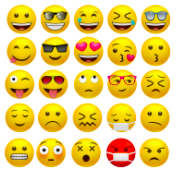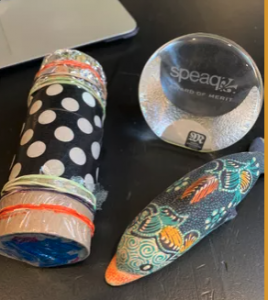Icebreakers for the Online Classroom
Spring is here, the snow is melting, and ice is breaking everywhere! Inspired by nature, we want to share some engaging icebreakers that we have been using in our online workshops.
Icebreakers are short, fun activities that help develop skills like team-building, social interaction, sharing, and empathy. We usually use them at the beginning of the year to help forge a bond between students, and between students and the teacher. But, because they have so many benefits, they can actually be used throughout the year for all those same reasons!
Since many teachers have had to teach online at some point this year, we have assembled a list of our favourites to share with you-and even one for you to try right now!
Here’s the challenge!
Look around your house and find the following objects:
- something round
- something that makes noise
- something that is special to you
Now let’s see what everyone found!
- Open the Padlet.
- Click on the pink + icon at the bottom right hand corner of the page.
- Upload a picture or take the picture directly in the Padlet, and write a comment about what you found.
- Read others’ responses.
You’ve just participated in our very first online blog icebreaker! Continue reading for icebreakers to try with your students!
Icebreaker |
Description |
Why It Works |
|
1. What Is Your |
At the beginning of the class, ask students to use emoji reactions to describe how they are feeling. This activity can also be used as a quick check-in during class or at the end of a session. |
|
| Ask students to send you a photo of their shoes to share with the class. The student tells the story of the shoes by explaining why the shoes are important, when they were last worn, what they represent. Other students are invited to ask questions. This could be done as a whole class, or with small groups in breakout rooms. |
|
|
| Ask students to share one good thing that happened to them. It could be something that someone did for them, or something that they did for someone else. Each student begins their statement with, “I am grateful for…” or “I am grateful to…”. (This activity reminds participants that there are many things to be grateful for, even during more difficult times.) |
|
|
| Cameras on! “One student assumes the role of, “Simon,” and gives instructions on actions to do, being sure to say, “Simon Says,” before each action. If they only say the command, without using, “Simon Says”, anyone who does the action becomes the new Simon! |
|
|
| Begin by giving a clue about one of the participants like “I spy something blue in someone’s background”. Invite students to guess which student’s background they are describing. The person who guesses correctly is the next person to give out a clue about someone else. |
|
|
| Send your participants on a hunt to find 3 objects in their house. Participants can show their object(s) to the camera and talk about what they found, or use an app like Padlet for them to make a class board. (See Challenge Icebreaker above.) |
|
|
| Send your participants on a hunt to find 3 random objects in their house. When they return, give students a scenario where they have to use one of the objects they chose. Students can also do this in breakout rooms with smaller groups. For game scenarios: Pick 3 Distance Learning Game |
|
|
| Ask students to come up with three statements about themselves. Two statements must be false and one must be true. Each participant must share their statements verbally while the other participants determine which statement is true. They can write their statements in the chat (numbering them 1, 2, 3), and ask participants to respond in the chat with their answer. |
|
|
| One participant thinks of a person, place or object, and draws it, writes it on a piece of paper, or holds the object in their hand. The other students must guess what the object is, by asking only yes/no questions. The group has 20 chances in the form of questions to figure out what the object is. |
|
|
|
10. Charades |
The teacher sends a few vocabulary words to a student via private message in the chat. That student chooses one of the words, acts it out, and the class tries to guess the word that is being acted out. Here is a fun list of words. |
|
| Ask students to bring in a photo of their weekend to present to the class without any explanation. Students must ask questions to find out where, what and with whom this activity was done. Ex.: Was it at a park? Is the person a family member? Do you like this activity? |
|
Carolyn Buteau and Elizabeth Alloul are both Pedagogical Consultants at LEARN. They enjoy hosting and participating in workshops, and love to share ideas with teachers!
Resources
Ice: Dyson, Dannielle. (2021, March 20). Ice. LEARN
Emojis: AnnaliseArt at Pixabay
Shoes: Ginny at Flickr
Gratitude : Julie Jordan Scott at flickr
Play blocks: Skitterphoto at Pexels
I Spy: levelord at Pixabay
Truth: geralt at Pixabay
20 Questions: geralt at Pixabay
Charades: Drama Face Theatre Masks drawing
Weekend photo: Netflix Night with Popcorn, Kostenloser photos











